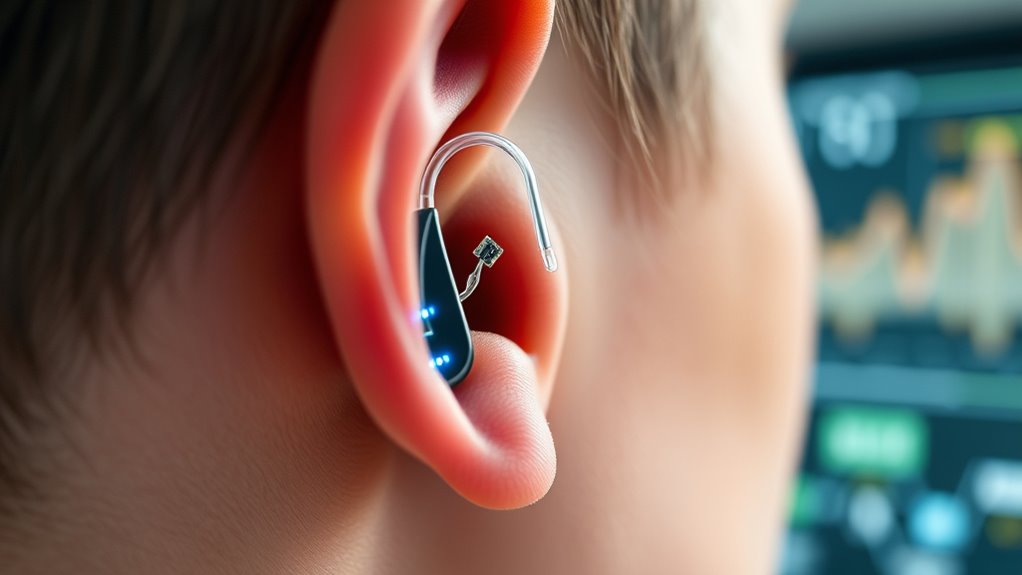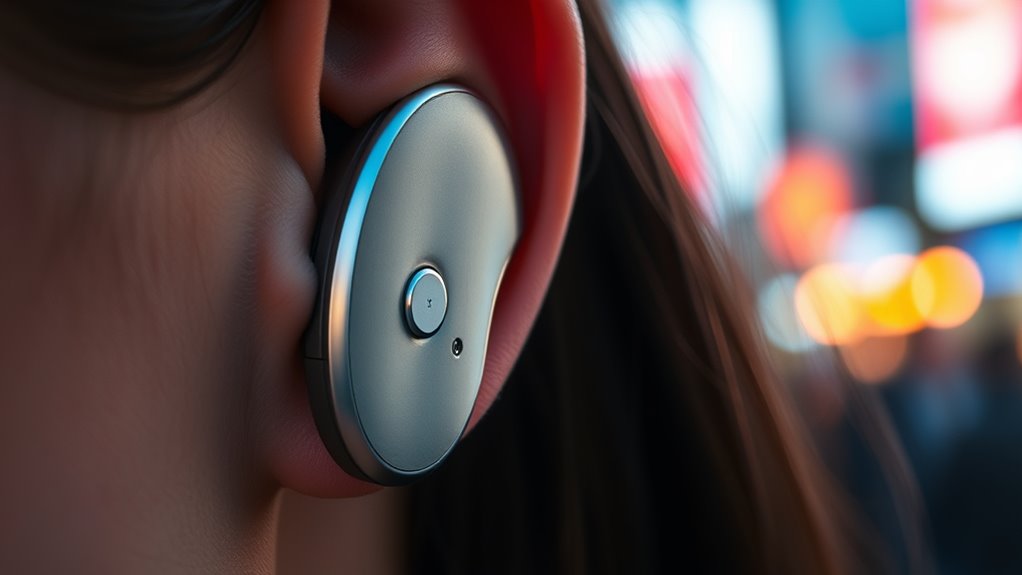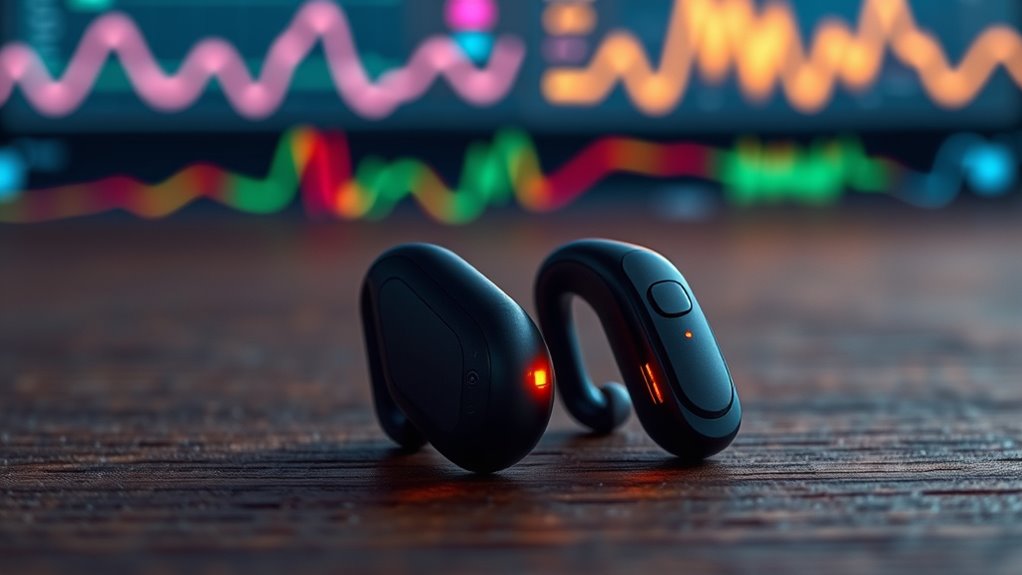AI-powered hearing aids use machine learning to analyze sounds in real time, allowing them to adapt instantly to your environment. These devices analyze complex sound patterns and differentiate speech from background noise, creating personalized settings based on your preferences and surroundings. They learn continuously to improve clarity and naturalness, adjusting for things like urban noise or quiet spaces. To understand how this cutting-edge technology works and benefits you, keep exploring the details below.
Key Takeaways
- Machine learning algorithms analyze ambient sounds to distinguish speech from background noise instantly.
- AI models create personalized hearing profiles based on user preferences and listening habits.
- Real-time environment detection allows hearing aids to adapt settings for optimal sound clarity.
- Continuous learning refines sound processing, adjusting to changing environments and user needs over time.
- Advanced filtering and AI-driven adjustments deliver natural, comfortable listening experiences tailored to each individual.
The Evolution of Hearing Aid Technology

The evolution of hearing aid technology has transformed how you experience the world around you. Historical milestones marked significant progress, from bulky, analog devices to sleek digital models. Early challenges included limited sound clarity and battery life, which hampered usability. Over time, technological challenges pushed innovators to develop miniaturized components and improve amplification quality. The introduction of digital signal processing in the late 20th century revolutionized hearing aids, enabling better noise reduction and more natural sound. These advancements laid the groundwork for modern devices, making them more discreet, powerful, and customizable. Today’s innovations continue to address previous limitations, setting the stage for further enhancements driven by new technologies like artificial intelligence. Incorporating advanced filtration techniques similar to those in air purifiers, modern hearing aids are better equipped to filter out background noise and improve sound clarity. This evolution reflects a persistent effort to improve your hearing experience continuously.
How Artificial Intelligence Enhances Sound Processing

Artificial intelligence has revolutionized how hearing aids process sound, making them smarter and more responsive to your environment. Neural networks analyze complex sound patterns in real time, allowing the device to distinguish speech from background noise more effectively. This advanced sound augmentation guarantees you hear conversations clearly, even in noisy settings. AI-powered hearing aids adapt instantly, filtering out unwanted sounds while amplifying important ones, giving you a more natural listening experience. By continuously learning from your environment, these devices improve over time, providing personalized sound processing tailored to your surroundings. The integration of automation technologies enables these devices to operate seamlessly and improve their performance through ongoing learning. This technology transforms hearing aids from simple amplifiers into intelligent systems that enhance your hearing with precision and clarity.
Machine Learning’s Role in Personalizing Auditory Experiences

Machine learning helps hearing aids adapt to your environment in real time, ensuring you hear what matters most. It analyzes your surroundings and adjusts sound processing accordingly, giving you a clearer experience. By creating personalized hearing profiles, these devices tailor sound to fit your unique preferences and needs. Additionally, advancements in sound processing technology contribute to more natural and accurate sound reproduction.
Adaptive Sound Processing
As you navigate different environments, adaptive sound processing uses machine learning to tailor audio experiences in real time. It analyzes sounds around you, enhancing voices through voice recognition to focus on speech and suppress background noise. Binaural synchronization ensures your hearing aids coordinate seamlessly, creating a balanced, natural soundscape. Machine learning algorithms continuously learn from your listening patterns, adjusting settings instantly to improve clarity and comfort. This dynamic adaptation helps you hear conversations clearly in noisy places, like restaurants or busy streets, without manual adjustments. Additionally, privacy considerations are integral to the technology, ensuring your data is protected while benefiting from personalized sound. By personalizing sound in real time, adaptive sound processing delivers a more natural auditory experience, making it easier to focus and enjoy your environment. It’s your hearing aids working intelligently to optimize sound precisely for your needs.
Contextual Environment Analysis
Building on adaptive sound processing, contextual environment analysis leverages machine learning to further personalize your hearing experience. It detects ambient soundscapes and interprets contextual cues, allowing your device to adapt instantly to changing environments. For example, it can distinguish between a busy street and a quiet café, adjusting noise reduction and amplification accordingly. This real-time analysis ensures you’re always tuned into the sounds that matter most, whether speech or ambient noise. The system continuously learns from your surroundings to optimize sound delivery. Here’s how it works:
| Environment Type | Key Features | Machine Learning Role |
|---|---|---|
| Urban Streets | Traffic, chatter, sirens | Identifies noise sources |
| Indoor Spaces | Conversations, background music | Differentiates speech from ambient sounds |
| Quiet Environments | Silence, minimal ambient noise | Enhances subtle sounds |
Personalized Hearing Profiles
Have you ever wondered how hearing aids can deliver a truly personalized experience? It’s thanks to personalized hearing profiles driven by machine learning. These profiles adapt to your unique hearing preferences, environment, and listening habits, offering tailored soundscapes. The system continuously learns from your interactions, refining customization options based on your feedback. When you adjust volume or switch settings, your hearing aids instantly incorporate that feedback, ensuring future sounds feel natural and comfortable. This dynamic process creates a seamless auditory experience that evolves with your needs, whether you’re in a noisy restaurant or quiet room. By integrating user feedback into the machine learning model, your hearing aids become more intuitive, providing a level of personalization that was impossible with traditional devices. Additionally, the best anime movies and emotionally touching animated films demonstrate how tailored experiences can deeply resonate with viewers, paralleling the personalized soundscapes created by advanced hearing aids.
Real-Time Sound Analysis and Environment Adaptation

AI-powered hearing aids can instantly detect changes in your environment, adjusting sounds dynamically to keep conversations clear. With advanced noise filtering, they reduce background noise without sacrificing important sounds. You’ll also experience personalized acoustic settings that adapt in real-time, enhancing comfort and understanding throughout your day. They may also incorporate sound analysis techniques similar to those used in aromatherapy for optimizing sensory experiences.
Dynamic Sound Environment Detection
As you move through different environments, your hearing needs constantly change, and advanced hearing aids now respond instantly to these shifts. They use dynamic sound environment detection to identify your surroundings through soundscape recognition and environmental classification. This process quickly analyzes sounds around you, determining whether you’re in a busy street, a quiet room, or a crowded restaurant. Incorporating green-chemistry principles, some devices are designed to minimize energy consumption and reduce environmental impact while maintaining high performance.
Key features include:
- Real-time adaptation based on environmental cues
- Differentiation of background noise from important sounds
- Automatic adjustment of amplification levels to suit the setting
Instant Noise Filtering Capabilities
Instant noise filtering capabilities enable your hearing aids to analyze sounds in real time, allowing for seamless environment adaptation. With advanced noise suppression, your devices can identify and reduce background noise, making conversations clearer. Speech enhancement focuses on amplifying human voices, even in noisy settings, so you can follow conversations effortlessly. These real-time processes constantly adjust to changing environments, ensuring you experience ideal sound clarity without manual adjustments. By filtering out unwanted sounds instantly, your hearing aids help you stay engaged in social situations and navigate busy places confidently. The combination of noise suppression and speech enhancement creates a more natural listening experience, allowing you to focus on what truly matters—your conversations and surroundings—without distraction or fatigue. Understanding fan culture and community dynamics can inform the development of personalized hearing experiences, making technology more attuned to individual needs.
Personalized Acoustic Adjustments
Building on the noise reduction features, personalized acoustic adjustments tailor your hearing aids to your unique listening environment in real time. These adjustments analyze sounds instantly, reducing cognitive load by making speech clearer and background noise less distracting. The device adapts to your surroundings, helping you focus without overloading your auditory memory. You’ll notice improved clarity during conversations and in busy settings. For example, dog names can inspire personalized options that reflect your lifestyle and preferences.
Benefits of AI-Driven Hearing Aids for Users

AI-driven hearing aids offer numerous benefits that can substantially improve your listening experience. They adapt in real time to your environment, providing clearer sound and reducing background noise, which enhances user comfort. This personalized adjustment means you won’t have to manually tweak settings constantly, allowing for a more natural hearing experience. Additionally, these devices optimize battery efficiency by adjusting power consumption based on your usage patterns, helping your hearing aids last longer between charges. The intelligent processing ensures you hear better in diverse scenarios, whether in a crowded room or quiet space. Overall, AI-powered hearing aids make listening easier and more comfortable, giving you a seamless connection to your surroundings while saving energy and reducing maintenance.
Future Trends in Smart Hearing Assistance

As technology continues to advance, smart hearing assistance is poised to become more integrated and intuitive than ever before. Future trends focus on enhancing user engagement through smarter algorithms that adapt seamlessly to your environment. Expect AI to personalize sound even more accurately, filtering out unnecessary noise and emphasizing speech naturally. Wearables will become more discreet and connected, integrating with other health devices for holistic care. However, ethical considerations will play a key role, ensuring data privacy and user consent remain priorities. You might see features like real-time language translation and emotion recognition, making interactions more meaningful. These innovations aim to create a more immersive and responsive experience, empowering you to stay connected with confidence and comfort.
Future smart hearing devices will personalize sound, enhance privacy, and offer immersive, connected experiences for confident, comfortable interactions.
- Smarter environment adaptation
- Increased focus on privacy and ethics
- Enhanced multi-sensory integration
Frequently Asked Questions
How Do AI Hearing AIds Compare Cost-Wise to Traditional Models?
Imagine paying a tiny fortune for basic hearing aids! Compared to traditional models, AI-powered hearing aids usually cost more upfront due to advanced technology. But, when considering affordability factors, they offer incredible value with personalized sound and fewer adjustments needed. While the initial investment is higher, their long-term benefits can save you money and improve quality of life, making them a smarter choice over time.
What Privacy Concerns Exist With AI Collecting User Environment Data?
You might worry about privacy when AI hearing aids collect environment data. It’s essential that manufacturers prioritize data security, protecting your information from breaches. Always guarantee they obtain your explicit user consent before gathering any data. This way, your personal environment remains confidential, and you’re aware of how your data is used. Trustworthy devices will clearly explain their privacy policies and give you control over your data sharing choices.
Can AI Hearing AIds Function Effectively in Extremely Noisy Settings?
In bustling environments, your hearing aids excel through advanced noise suppression and environmental adaptation. They actively filter out overwhelming sounds, ensuring clearer conversation and comfort. Machine learning enables these devices to adjust swiftly to dynamic noise levels, making them effective even in extremely noisy settings. You can trust them to help you focus on what matters most, providing a seamless listening experience despite the chaos around you.
How Long Does the Battery Last With Continuous AI Feature Usage?
You wonder about the battery life when using the AI features continuously. Typically, the power consumption of AI-enabled hearing aids is higher, so battery life may range from 12 to 24 hours on a full charge. Factors like your device’s efficiency and usage intensity affect this. To maximize battery life, consider turning off AI features when not needed or opting for models with larger batteries.
Are There Any Health Risks Associated With Long-Term AI Hearing AId Use?
You might wonder if long-term AI hearing aid use impacts your health. Generally, these devices are designed with hearing safety in mind, and current research shows minimal long-term health risks. However, it’s essential to have regular check-ups to monitor your hearing health. Using your hearing aids properly and following your audiologist’s advice helps ensure your long-term safety and preserves your hearing quality.
Conclusion
AI-powered hearing aids are transforming how you experience sound, making your auditory environment more personalized and adaptable than ever before. With machine learning, you don’t have to settle for a one-size-fits-all solution; instead, these devices learn and adjust to your unique needs in real time. As technology advances, you’ll find yourself ahead of the curve, proving that sometimes, it’s better to be a step ahead than to follow the crowd.











